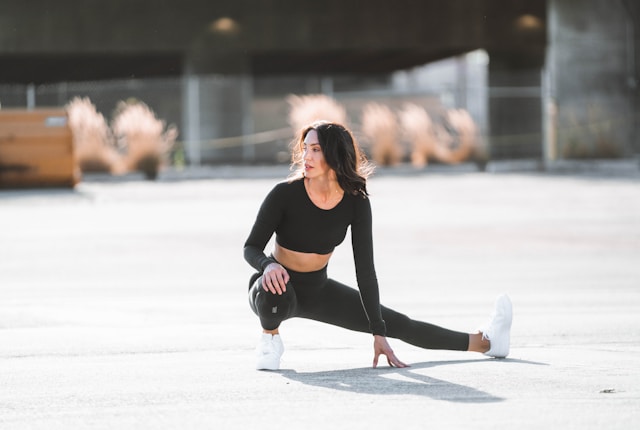5 Simple Workouts You Can Do at Home Without Equipment

You don't have to go to the gym. Five simple exercises are enough for a full-body workout: push-ups, squats, planks, lunges, and bicycle crunches. They help make you stronger and more energetic with no equipment required. Any person can do these, and you can modify them according to your level and objectives.
PushUps: Build Upper Body Strength
Push-ups are one of the simple and very useful exercises that will help you strengthen the upper body. They target several muscle groups simultaneously, which include the chest, shoulders, triceps, and core. Regularly performing push-ups increases endurance, helps improve posture, and strengthens the upper body generally. For the standard push-up, lie facing down with your hands on the floor a little wider than your shoulder width.
Straighten your body with your legs, and tuck your toes underneath, making a straight line from head to heels. Begin by lowering your body down to the ground, keeping your elbows at a 45-degree angle to your body. Your core should be tight and your back straight so that your hips do not sag. Push back up through your hands from just above the ground to extend your arms and return to the starting position.
That is one push-up. There are several types of push-ups to suit every fitness level. Knee push-ups are more comfortable on the upper body and core for starters. For a higher level of challenge, use an incline bench or step for push-ups and decline push-ups with elevated feet. The clap push-up needs to have enough strength to clap hands mid-air after pushing off the floor. Push-ups are a total exercise that works on the upper body, core, and lower body and provides stability. Push-ups can be added to your exercise routine to build stronger arms, chest, and core, among other improvements in strength.
Squats: Strengthen Your Legs and Glutes
Squats are a basic exercise that strengthens the legs and the butt. It works on very important muscles of the thighs, hips, and calves. Squats are fantastic for making the legs stronger and toning the lower body. It also helps in balance as it uses the core muscles for support. Stand with your feet spread at shoulder width, toes outward. Engage your core; maintain a vertical posture with a raised chest and elongated spine.
Imagine that you are lowering yourself into an imaginary chair. Sit down slowly by pushing back with your hips. Lowering your body, bend your knees downward while keeping your knees aligned with the direction of your toes. Let your thighs bend down parallel to the ground as low as is feasible. You can then push through your heels to get back up.
There are various types of squats, and they enable you to work on different muscles. Jump squats add a jump at the top, which raises the intensity and works different leg muscles. Bulgarian split squats target the glutes and thighs specifically by putting one leg on a bench behind you, which increases stability. For those who require a challenge, you can try single-leg squats, concentrating on one leg at a time. Squats enhance hip, knee, and ankle movement while developing strength in the legs, mainly targeting the glutes and thighs. Regular squats improve posture, efficiency of movement, and metabolism through the activation of large muscles, which require lots of energy.
Planks: Strengthen Your Core
Planks are one of the best exercises to help strengthen your core and make it stable. Planks work out the belly, sides, shoulders, and lower back, and are a great overall exercise for building core muscles. Doing planks also helps enhance one's posture, balance, and movement which is very useful for physical activity. Basic plank lie on your stomach with forearms on the floor. Keep your elbows under your shoulders.
Place forearms on the floor, lift the body off the floor, legs straight, a straight line from head to heels. Tighten in core and keep the hips from sagging. Keep your body stiff as long as you can. The plank exercises can be modified according to fitness level. For instance, beginners can start with a knee plank. They place their knees on the ground to ease themselves.
Those who are advanced can try side planks. This targets the sides of the belly and helps to stabilize. There are ways to do plank exercises so that they will be more challenging and engage more muscles. The regular performance of planks will strengthen both the core and lower back and increase stability, thus reducing the risk of injury. It also helps you daily with bending, lifting, or twisting. Doing plank exercises can improve general mobility, and your performance in sports and games, and maintain the back's health.
Lunges: Target Your Legs and Glutes
Lunges are a great exercise for your legs and butt. They mainly target your thigh muscles (quadriceps and hamstrings), butt (glutes), and calves. Lunges strengthen hip, core, and lower back muscles to enhance balance and coordination. You can do lunges in one spot or while walking. To do a basic lunge, stand with your feet shoulder-width apart. Step one foot forward and lower your body so both knees bend at about a 90-degree angle.
Keep the back knee near the ground and the front knee above the ankle, avoiding surpassing your toes. Push through your front foot to come back up to standing. After that, repeat with the opposite leg. That counts as one rep. There are many ways to make lunges harder. For example, in a reverse lunge, you step back instead of forward, which targets your glutes and hamstrings more.
Walking lunges require alternating legs to move forward, engaging legs, and core muscles, and increasing heart rate. If you want an even bigger challenge, try jumping lunges, where you jump from one lunge to the next. Doing lunges can help make your lower body stronger, increase flexibility, and make your legs look better. Including lunges in your workout boosts leg and butt strength, enhances balance, and improves stability.
Bicycle Crunches: Engage Your Abs and Obliques
Bicycle crunches are a great exercise for working on your tummy muscles, especially the sides. They help strengthen both the upper and lower abs, making your waist look nice. To do bicycle crunches, lie on your back with your hands behind your head and your knees bent. Raise your shoulders, head, and neck off the floor. Bring one knee towards your chest while turning your body to touch that knee with the opposite elbow. While doing this, keep the other leg straight out.
Move slowly and carefully, switching from side to side like you’re pedaling a bike. Bicycle crunches are effective because they work many parts of your core muscles. Doing them slowly and properly helps use your abs and oblique muscles better. For added difficulty, briefly pause at the peak of each twist to further enhance muscle strength.
These crunches not only help tone your abs but also improve your coordination and flexibility in your back and hips. Include bicycle crunches in your routine for a toned belly and improved strength that benefits daily activities and sports. As you grow stronger, increase repetitions or vary movements by raising your legs or increasing speed to maintain the challenge. Overall, this exercise is a great addition to any routine for strengthening your abs.
Conclusion
Incorporating basic bodyweight exercises into your daily routine at home can boost fitness, strength, and health. These exercises work well, don't need any special equipment, and can be adjusted to match your fitness level. These exercises provide a complete workout, targeting multiple muscles simultaneously to enhance endurance, build muscle, and increase flexibility. Staying dedicated leads to strength, posture, and body shape enhancements, making tasks easier and assisting in achieving fitness goals.








